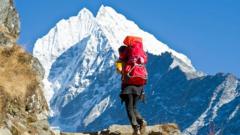Nepal is taking significant steps to promote less-explored regions by eliminating climbing fees for 97 of its Himalayan peaks, a strategic initiative expected to last for two years. This announcement coincides with a notable increase in permit fees for Mount Everest, the tallest mountain in the world, which will rise to $15,000 (£11,170) for the upcoming peak season — the first adjustment in nearly a decade.
The Nepali tourism department has stated that this initiative aims to draw attention to the country's diverse tourism offerings and hidden gems. Mountaineering is an essential revenue source for Nepal, with climbing fees contributing $5.9 million last year, with Everest making up over 75% of that revenue.
The free-to-climb peaks are situated in the Karnali and Sudurpaschim provinces, known for being impoverished and remote. Despite their stunning landscapes, tourism in these areas has remained limited, attributed largely to difficult access. Himal Gautam, director of the Nepal Tourism Department, expressed optimism that this initiative could transform local economies by creating jobs and increasing income. However, the effectiveness of this plan hinges on the government’s ability to improve infrastructure and manage an influx of tourists, as only 68 climbers visited these peaks in the past two years compared to 421 permits for Everest in 2024 alone.
With Everest suffering from overcrowding and environmental issues, Nepal's Supreme Court has mandated a cap on permits, emphasizing the need for sustainable climbing practices. Additionally, a proposed law may require climbers to have previously summited a mountain over 7,000m in Nepal, making the newly free peaks an accessible training ground for aspiring Everest climbers.
The Nepali tourism department has stated that this initiative aims to draw attention to the country's diverse tourism offerings and hidden gems. Mountaineering is an essential revenue source for Nepal, with climbing fees contributing $5.9 million last year, with Everest making up over 75% of that revenue.
The free-to-climb peaks are situated in the Karnali and Sudurpaschim provinces, known for being impoverished and remote. Despite their stunning landscapes, tourism in these areas has remained limited, attributed largely to difficult access. Himal Gautam, director of the Nepal Tourism Department, expressed optimism that this initiative could transform local economies by creating jobs and increasing income. However, the effectiveness of this plan hinges on the government’s ability to improve infrastructure and manage an influx of tourists, as only 68 climbers visited these peaks in the past two years compared to 421 permits for Everest in 2024 alone.
With Everest suffering from overcrowding and environmental issues, Nepal's Supreme Court has mandated a cap on permits, emphasizing the need for sustainable climbing practices. Additionally, a proposed law may require climbers to have previously summited a mountain over 7,000m in Nepal, making the newly free peaks an accessible training ground for aspiring Everest climbers.






















